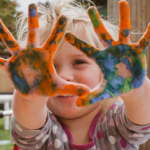01 Dec Caring for Hanna
Katrina Hartley’s daughter, who was born with spina bifida, made a successful transition to school.
My daughter Hanna was born 7 years ago. While most parents agree that tiredness is a part of parenting, my husband, Bruce, and I are truly exhausted as Hanna was born with the condition called spina bifida. However, our beautiful girl wakes most mornings with a huge smile on her face. She has the best smile and she gives great bear hugs. Hanna’s laughter is infectious. She truly loves life and it is a joy to have her with us.
Somewhere deep inside I know that Hanna will be okay. I know she has a lot to teach able-bodied people and I hope, as parents, we give her the room to grow as we do our other children (who include two older brothers and one younger brother).
When Hanna was born and we were told she had spina bifida, the diagnosis was totally unexpected. I had a great pregnancy and a good labour and Hanna appeared to be a beautiful, healthy baby.
While I was having a cuddle, though, we noticed that she had a sac of fluid on her lower back. Our midwife took Hanna down to the special-care nursery to check it out. Within an hour of being born, Hanna was transferred to a major metropolitan hospital. Bruce and I followed in the car a couple of hours later, not knowing what to expect.
We were told she had a moderate form of myelomeningocele (the most serious form of spina bifida), and that she would be having surgery the next morning to repair the hole in her back. Nine days after that, Hanna had more neurosurgery. Finally, after five weeks, we brought our little girl home, believing we would not have to go back to hospital except for the odd check-up. Well, how stupid were we!
Since Hanna’s birth, she has had 15 major surgical procedures, more than 30 hospital admittances and has tolerated hundreds of blood tests, X-rays and scans. A number of times I thought that she might actually die.
Most of this happened in the first two years of Hanna’s life. I can’t remember being around much for her older brothers, Ben and Sean, and I think that this has been the hardest part of the journey with Hanna – missing watching my little boys grow up.
Even though I cared for Hanna 24 hours a day, seven days a week, I never really thought of her as being disabled. It’s not until we went to a birthday party, or perhaps swimming, and I am confronted by the differences between Hanna and the other kids, that I think about it. So starting preschool was hard. At this stage, Hanna used Makaton (sign language) to communicate and could not sit on the floor unaided.
Hanna had a great two years at at preschool, with the fantastic support of a full-time aide, a young, motivated teacher and a great group of friends. But then we had to make the decision about school. There had to be assessments from all of the therapists involved with her care. Everyone was telling us they didn’t know if she would cope at a mainstream school – maybe we should consider a special school. How could we send Hanna to a different school from her brothers’? How could we tell her she was different, that she didn’t belong with her friends any more? No way!
Hanna’s first year at school was a huge success. It had been a very positive experience and she loved being there. I can’t compare her to the other children – academically she is on a different playing field, but there was no hurry. She will reach her goals. Hanna has definitely been embraced as part of the school community and is loved for who she is. What more could we ask for? Well, the school council asked if they could help raise some money for Hanna’s much-needed new wheelchair and, they did – they raised the whole amount, with enough money left over to purchase a mobile stander as well.
We learnt that Hanna’s abilities are endless – the disability is only a small part of who she is.
About Spinabifida
- Spina bifida is a malformation of the spinal cord and it occurs in the first 21 days of pregnancy.
- In spina bifida, the neural tube has failed to form completely at some point along the baby’s back. As a result, the spinal cord and nerves may be damaged.
- In Australia, one in 800 pregnancies is identified with a neural tube defect.
- Anyone could potentially have a baby with a neural tube defect, even if there is no family history.
- Research has shown that taking a vitamin called folate (from folic acid) prior to and during early pregnancy can reduce the risk of having a baby with a neural tube defect by up to 70 per cent.
- Folate is a B-group vitamin found in foods such as leafy green vegetables, legumes (such as chick peas, dried beans and peas and lentils) and wholegrain breads and cereals that have been fortified with folic acid. It is also available in tablet form as folic acid.
For Further Information:




